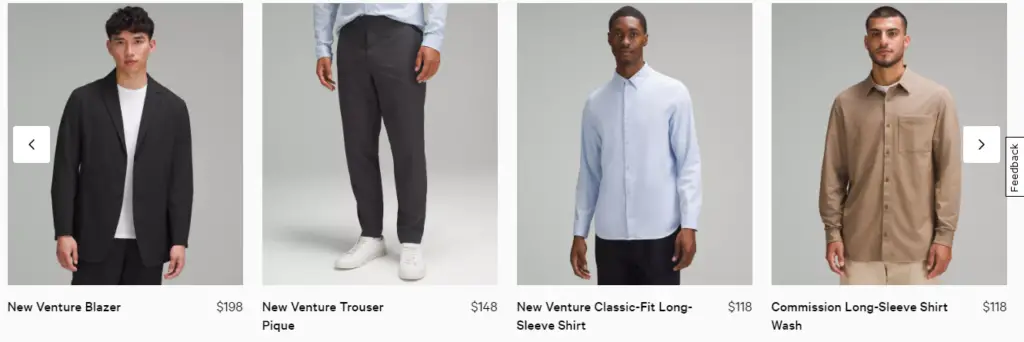Lululemon marketing strategies combine the use of micro-influencers, social media, community, and in-store marketing. Other marketing strategies employed by the company include product scarcity, fabric exclusivity, as well as fashion and functionality of products.
Lululemon Athletica Inc. is a multinational athletic apparel retailer that has Canadian roots. It was founded in Vancouver, Canada in 1998 by Chip Wilson. It is most commonly referred to as Lululemon.
The company was incorporated in the United States and has its headquarters in British Columbia, Canada. As of August 2023, the brand has over 660 stores and 34,000 employees worldwide.
Lululemon initially operated as a women’s yoga apparel retailer but has now expanded to accommodate men and young girls too. The brand’s investment and subsequent acquisition of Mirror in 2020 further expanded the reach of the brand. Mirror is a fitness interactive mirror with speakers and a camera used for home workouts.
These expansions have increased Lululemon’s product categories to include different personal care products, athletic wear, shoes, lifestyle apparel, and accessories for both men and women.
The growth of the brand can be attributed to its effective use of one of the pricing strategies in marketing which is the premium pricing strategy. This pricing strategy enables the company is charge a high price for its products thereby boosting its profit margins considerably.
Lululemon has appeared consecutively from 2010 to 2013 on Fortune’s Fastest-Growing Companies list. It has also recorded steady revenue growth with up to 30% increase in 2022 at $8.1 billion revenue.
Here, we shall discuss Lululemon’s marketing strategies as well as how the marketing mix influences these strategies. Before we do that, let us understand the meaning of marketing strategies.
See also: Subway Positioning and Marketing Strategies
What are marketing strategies?
Marketing strategies refer to a corporation’s promotional efforts aimed at the effective allocation of time and resources to position the brand and its products or services through a platform that increases its visibility. This is mainly aimed at having a holistic view of the brand, increasing consumer access to its products or services, and consequently increasing sales.
The concept of strategic marketing emerged in the 1970s and 80s. It highlights the role of marketing as a link between a business and its customers. This is done by the effective use of a brand’s resources and capabilities to aid it in achieving a competitive advantage over similar businesses.
The marketing strategy of any organization is one of its most important assets. It primarily influences how, when, and where customers discover a brand as well as the products or services the brand offers. It also influences the consumer’s perception of the brand, its products, and services.

Through Lululemon’s marketing strategies, the brand was able to position itself as a provider of high-quality and comfortable yoga wear. With its expansion into becoming an athleisure brand with a broader product offering, the company still leverages its marketing strategies to reach its expanded customer base.
See also: Demographic Marketing Definition and Importance
Lululemon marketing mix
- Product
- Price
- Place
- Promotion
The marketing mix refers to a set of marketing tools as proposed by E. Jerome McCarthy in 1960 and popularized by Philip Kotler which are useful in marketing decision-making.
The marketing mix, otherwise referred to as the 4Ps, is used by organizations to pursue their marketing objectives within their target market.
Lululemon’s marketing mix has been useful in navigating its marketing strategies. These 4Ps have guided the brand’s product offerings, pricing strategies, store locations, and promotional efforts.
These have contributed positively to Lululemon’s position as a trailblazer in the athleisure industry. Let us discuss each of the 4Ps as implemented by the company.
Lululemon products
The product is the first marketing mix of Lululemon. The company has distinguished itself as a producer of fashionable and functional apparel that can be comfortably used both for workouts and other activities.

The brand products include apparel for women, men, and children, accessories, shoes, and personal care products. They also offer a limited edition of apparel in specific colors and prints inspired by art, cultural trends, or nature as seasonal collections.
Price
In the aspect of pricing, Lululemon charges a bit higher than other athleisure brands. For instance, in September 2023, yoga pants from the brand cost between $88 to $138 while its competitors such as Adidas sell their yoga pants between $45 to $100.
This higher pricing is a type of pricing strategy known as luxury pricing. Lululemon however attributes its higher pricing to the brand’s commitment to the ethical manufacturing of its products as well as its use of premium materials.
Other factors that influence the prices of Lululemon products include the product category, the design complexity, and the fabric composition.
For instance, pants are generally priced higher than tops. Apperals with printed patterns and made from cotton blends are also more expensive than plain apparel made from nylon blends.
Place
The brand has effectively utilized the third ‘P’ in the marketing mix which is place; it has strategically expanded its presence to about 18 countries including the United States, China, the United Kingdom, and Germany.
Most Lululemon stores are located in areas that maximize the brand’s visibility and offer convenience to customers such as malls, tourist destinations, fitness clubs, and downtown areas.
The brand’s commitment to sustainable use of resources and environmental protection is also applied to its stores as most of them are fitted with energy-efficient lighting. They also use green cleaning supplies and incorporate recycled materials to reduce their carbon footprint.
In most instances, the stores also serve as a place for community engagements, especially yoga classes and other fitness-centered events.
Promotion
Promotion is another aspect of Lululemon’s marketing mix. The brand uses a combination of influencer marketing, grassroots awareness, and in-store display advertising to attract customers.
By hosting customers in the shop for meetups and events, Lululemon gains a competitive advantage for its brand by attracting more foot traffic to its stores. With the increased traffic, it also serves as a means of subtly advertising the store’s merchandise.
Sometimes, it may also result in some individuals impulsively making purchases. Aside from in-store promotion, the company also uses digital media for the promotion of its products.
See also: Product Marketing Strategies Examples
How does Lululemon advertise?
Lululemon advertises using a combination of marketing strategies including digital marketing, micro-influencers, and in-store advertising.
The combination of different methods of advertising enables the brand to reach a wider range of customers both physically and online. This varied customer base comprises fitness trainers, fitness enthusiasts, and individuals who value athleisure apparel.
See also: Digital and Physical Marketing Examples and Differences
Lululemon Marketing Strategies
- Use of micro-influencers
- Community-based marketing
- Social media advertising
- Retargeting ads
- Athleisure
- Limited product quantities
- Effective customer service
- Exclusive fabrics
- Affiliate marketing
Use of microinfluencers
The use of micro-influencers is one of the marketing strategies used by Lululemon. This entails engaging content creators, coaches, trainers, and fitness enthusiasts to share their experience using the brand’s products with their immediate communities.
The use of micro-influencers as a marketing strategy by Lululemon has proven beneficial to the brand. This is because by narrowing it down to micro-influencers, it is easier to get people in the micro-influencers community to patronize the brand due to the personal relationship these people have with the micro-influencer.
Lululemon has 2 programs through which it implements its microinfluencing marketing strategy. It includes:
- Ambassador program
- Sweat collective
Ambassador program
The ambassador program is one of Lululemon’s marketing strategies, it involves marketing the brand’s products through inspiring storytellers, leaders, and doers across the globe.
The ambassador program is open to yogis, runners, studio owners, teachers, artists, and all individuals who are leaders of or have access to a community of people and can inspire and influence them to try Lululemon products.
The brand uses the sweat, grow, and connect criteria when accessing individuals interested in joining the ambassadorial program. Thus, Lulumon ambassadors are individuals who love to sweat, are committed to personal, professional, and communal growth, and can connect with other individuals, primarily through fitness activities.

Lululemon ambassadors get access to development tools, get products to test, and have the opportunity to connect with other ambassadors. The ambassadors, in turn, provide the brand with invaluable feedback about their communities’ perceptions and experiences using the brand’s products.
Most ambassadors are individuals who have a reputation that can be trusted. This trait makes it easier for other individuals to trust the ambassador’s opinion on the brand’s products. Some Lululemon ambassadors include fitness yoga influencer, Pilin Anice, the Olympic swimmer, Summer McIntosh, and the Triathlete, Lionel Sanders.
This marketing strategy of Lululemon works because it is beneficial to both its ambassadors and the brand. The ambassadors get to test products before they are available to other customers and also gain access to new opportunities. The company on the other hand gets feedback that helps it to improve and grow its products to meet consumer needs while expanding patronage.
Sweat collective
This Lululemon marketing strategy involves using personal or group fitness instructors, team managers, gym and studio owners, coaches, self-employed personal trainers, athletes, and athletic trainers of teams to drive sales.
The sweat collective comprises a diverse group of individuals connected by dedication to an active lifestyle, community leadership, and a love of Lululemon.
Members of the sweat collective get special perks for teaching classes, coaching, and being a leader in fitness in their community. Part of the perks include getting 25% off Lululemon products, having access to special events that are restricted to only collective members, and being able to help the brand improve designs through the feedback they provide.
This Lululemon marketing strategy leverages the access of the Sweat Collective members to a community to market their products. For instance, if a studio owner is part of the sweat collective, they could easily market the brand’s products to their studio patrons.
This form of microinfluencing is often very effective because the microinfluencer has direct contact with the individuals to whom they market the product.
Additionally, as a leader in the fitness community, members are more likely to trust the leader’s recommendation on the choice of apparel to use for their fitness training. Therefore, the sweat collective serves as one of Lululemon’s marketing strategies.
Community-based marketing
Community-based marketing is another strategy that the brand implements. This has been part of the foundational marketing strategies of Lululemon right from its inception.
When the brand began in 1998, its store in Vancouver, Canada also served as a community hub where people could learn and discuss the physical and mental aspects of healthy living. Through this means Lululemon customers get the opportunity to learn and discuss various topics ranging from yoga, cycling, running, dieting, etc.
The brand’s utilization of community-based marketing is aimed at making customers feel that by using Lululemon products, they are part of a larger community of like-minded individuals.
The community supports individuals of diverse races, ethnicities, and body shapes. Hence, supporting a wide range of people, informing them that every look is beautiful, has the right to be loved, enjoy the freedom to dress, choose comfortable clothes, and keep fit.

Other community-centered activities that occur at the stores such as group fitness activities, workshops, charity initiatives, and volunteering opportunities further foster the community spirit by helping the consumers interact with each other. They also get to interact with the company’s staff who can offer valuable insights on how to use the brand’s products and the right apparel for various physical activities.
The community-based marketing strategy of Lululemon is still being utilized by the brand in all its physical stores and has been of immense benefit to the brand as it exposes more individuals to the diverse product offerings of Lululemon.
Social media advertising
Social media advertising is another Lululemon marketing strategy. The company uses social media platforms such as Facebook, Twitter(X), and Instagram to market the brand as well as its products to customers. They do so through posts focused on diverse topics such as sleep, stress management, exercise, mental health, nutrition, and environmental responsibility.
The brand’s social media marketing strategy is centered on promoting a healthy lifestyle to customers through subconsciously instilling in them that the brand and its products assist them in achieving a more active and healthy lifestyle.
The brand also uses its social media platforms to engage its customers by actively soliciting their feedback on products and other in-store experiences.
Apart from the brand’s dedicated social media handles, they also engage social media creators through the Lululemon creator network. These creators also help in marketing the brand on their various pages through their posts.
The creators usually post their workouts in Lululemon clothing, active imagery, and other fitness-related activities while incorporating how the brand’s products aid them in achieving their various feats.
Other Lululemon customers are also encouraged to post about their experience with the brand and its products using the hashtag, #thesweatlife. This creates more traction and lets consumers easily connect with other users of the brand’s products; thereby building a wider community of users who can easily interact with each other and share their experience.
For example, in light of the 2020 Christmas holiday season, Lululemon launched a marketing campaign, tagged Let the Feeling Flow for the month of December across the United Kingdom and Europe. The campaign encourages customers to celebrate the connection and growth in their journey by sharing their stories during the holiday season. Especially noting the changes that have come with the global pandemic.
The use of social media advertising as part of Lululemon’s marketing strategy is especially effective because a lot of individuals spend a significant amount of their time on social media. It is also effective due to people’s consciousness about leading a healthy lifestyle through regular physical activities which entails purchasing the right clothing for such activities.
Retargeting ads
Similar to other companies that operate in this technologically driven era where digital marketing is at the forefront of marketing campaigns, one of Lululemon’s marketing strategies is the use of retargeting ads.
This kind of marketing is targeted at individuals who have previously visited the brand’s website, mobile app, or online store but left without making or completing their purchase.
Retargeting ads mostly come in the form of pop-ups that appear on websites or social media. These pop-ups usually contain adverts for products that the individual had previously checked. They may also contain links for making or completing one’s purchase.
Email marketing is also used for retargeting consumers and encouraging them to patronize the brand. Retargeting ads are used as a marketing strategy by Lululemon to convert leads into sales by convincing individuals and ensuring that a large percentage of people who visit the company’s site make a purchase.
Athleisure
As people get more aware and engaged in pursuing an active and healthy lifestyle, the athleisure industry has witnessed exponential growth. This is because more people are shopping for apparel that can serve the dual purpose of being used as everyday wear as well as for athletic activities. This dual use of apparel is behind the athleisure tag which combines athletics and leisure.
Lululemon’s marketing strategy as an athleisure brand offers consumers time and money saving. It saves consumers time by allowing them to easily switch from leisure to work without wasting time on changing wears. It also saves them money because they do not have to spend on buying different clothes for athletics and leisure. Instead, the same clothes they use for leisure can also be used for athletics.
In essence, being an athleisure brand is another vital marketing strategy for Lululemon in capturing consumers who want to easily blend their everyday activities with fitness and staying healthy.
Limited product quantities
Limited product quantities are one of Lululemon’s marketing strategies. It involves stocking a limited amount of products at the brand’s stores at a time. This creates a sense of urgency for customers to quickly buy the products before they get sold out.
Additionally, the limited stock builds expectations in customers as they keep tabs on the brand to get informed about when stores will restock. The offering of seasonal and other time-bound temporary products in-store further heightens consumer interest in the brand and encourages patronage for such limited products.
Lululemon further uses pop-up stores in different areas or countries to sell its products for a specified period in new or emerging markets. This enables the brand to analyze whether opening a permanent store at such a location is profitable or not.
The brand also employs seasonal in-store or online discounts at different times of the year to encourage physical or online purchases of the products on discount sales. It also serves as a means of enticing customers to try out new styles or upgraded products at discounted prices.
All these marketing strategies are based on limited product offerings. Lululemon uses them to build consumer anticipation and ensure that they do not have a huge amount of inventory.
Effective customer service
Lululemon’s marketing strategies also include effective customer service. The brand calls its employees educators, this implies that they are not just there to sell products but to also educate the brand’s customers and how best to use the products.
Hence, Lululemon employs individuals who are passionate about fitness and approach sales from the perspective of adding value and improving the health and fitness lifestyle of the store patrons.
These in-store employees also receive feedback from customers about their experience using the products and pass it on to the company. The company utilizes the feedback in subsequent productions for further research, development, and improvement.
Through effective customer service, Lululemon gets to better understand consumer expectations and curate its products to meet them. This builds customer loyalty and confidence in the brand as they know that the brand works with their satisfaction in mind when creating products.
The company’s expansion to more countries such as the United States, Australia, Germany, and the United Kingdom further aids the company in effectively serving its growing customer base that is scattered across the globe.
Exclusive fabrics
Part of Lululemon’s marketing strategies is the use of exclusive fabrics for its apparel. These fabrics are specially developed through thorough research which is carried out by the brand’s research and development team in its Canade lab called Whitespace.
The researchers and designers of Lululemon’s products are individuals who are actively involved in fitness activities themselves. They also depend on feedback from the brand’s ambassadors, affiliates, creators, and teeming customer base when developing new fabrics or improving existing ones.
These exclusive fabrics include moisture-wicking designs that easily absorb sweat away from the skin, stretch without tearing or losing shape, and offer UPF protection against harmful UV rays.
The exclusive fabrics are made from a blend of different fabrics to ensure they meet high-quality standards. They also make exercising more comfortable for individuals. Hence, encouraging customers to buy the brand’s products despite their higher pricing in the market.
For instance, the brand uses Luon or Nulu for its yoga wear. These fabrics are made of a high nylon microfiber composition which makes it excellent for yoga due to its lightweight and stretchyness that allows unrestricted movement.

Everlux is designed for sweaty workouts hence it has the feature of quick drying thereby keeping moisture away from the skin and letting people exercise comfortably.
Lululemon’s marketing strategy through exclusive fabrics has been effective because of its unique quality and the fact that products made from the fabrics can only be accessed in the brand’s stores. This also serves as a differentiator for the brand’s products when compared to other brands.
Affiliate marketing
The Lululemon affiliate program is another marketing strategy used by the company. The brand calls its affiliate program the Lululemon Collective. It is designed for individuals who want to help the brand in marketing their brand and products on their websites, blogs, social media, or other digital platforms such as YouTube.
In exchange for this marketing effort, the affiliate gets a 7% commission on what people purchase through their posts. Due to this high commission rate and affiliates’ passion for fitness, most affiliates doggedly use their platform to ensure that their subscribers, readers, or followers get their active wear from Lululemon.
The brand’s use of affiliates adds to the other marketing strategies employed by the company to generate more sales and improve overall revenue.
See also: Societal marketing definition and examples
What marketing strategies does Lululemon use?
Lululemon uses several marketing strategies including social media, community-based, and affiliate marketing. They also use ads retargeting, limited product quantities, and effective customer service as part of their marketing strategies.
Additional marketing strategies used by Lululemon include its positioning as an athleisure brand, the use of exclusive fabrics in its products, and micro-influencing.
Conclusion
The Lululemon marketing strategies are based on extensive market research which takes into account the brand’s consumer base and the right tactics through which they can be reached.
The company’s most outstanding marketing strategies are the exclusive high-quality fabrics it uses in making apparel, its community engagement both in-store and online as well as its use of microinfluencers to market its products.
Lululemon’s marketing strategies have contributed to making the company a formidable force in the athleisure industry while serving its customers apparel that is suitable for both athletics and leisure.
Last Updated on November 2, 2023 by Nansel Nanzip BongdapBlessing's experience lies in business, finance, literature, and marketing. She enjoys writing or editing in these fields, reflecting her experiences and expertise in all the content that she writes.

